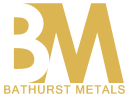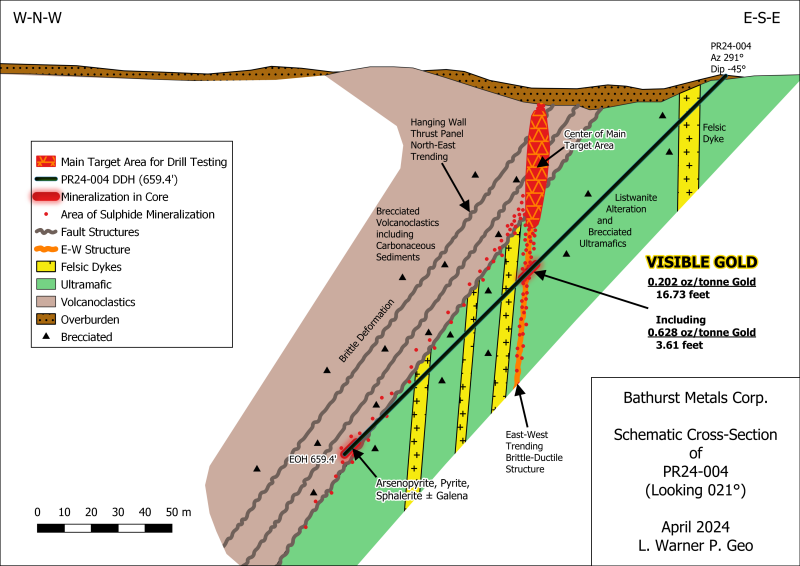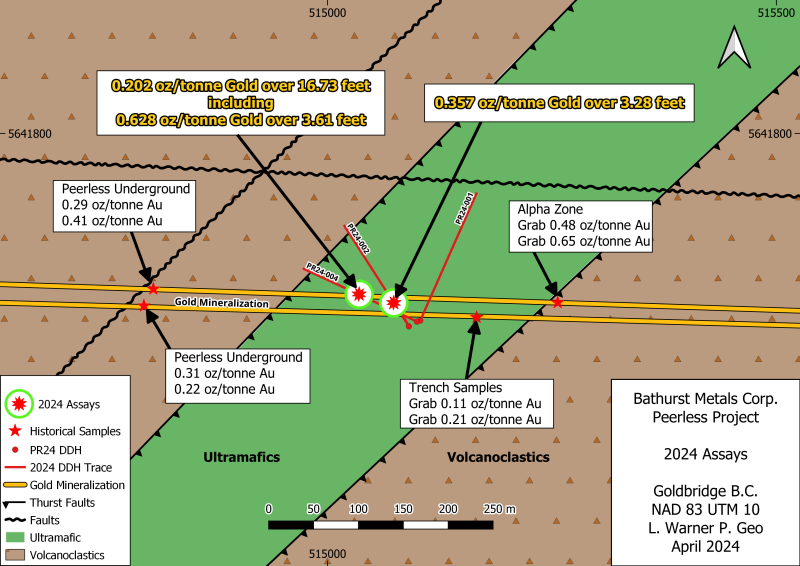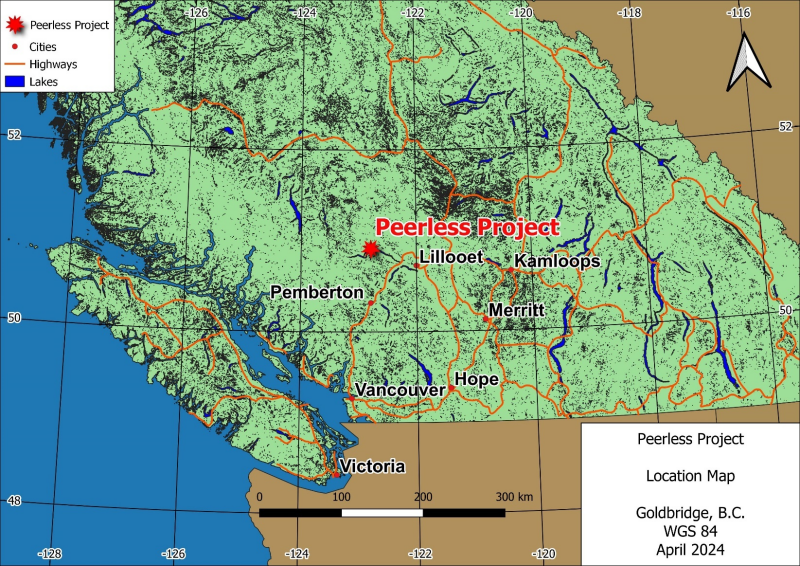Archive
Bathurst Metals Discovers High_Grade Gold in First Drill Program at the Peerless Gold Project
 | |||||||||
 |  | ||||||||
Vancouver, B.C. - TheNewswire - May 22, 2024 – Bathurst Metals Corp. (“Bathurst” or the “Company”) is pleased to announce assay results from the company’s first diamond drilling program on our Peerless Project located in the Bralorne mining camp area of British Columbia. Hole PR24-04 returned 0.20 oz/tonne gold over 16.73 feet including 0.63 oz/tonne gold over 3.61 feet.
The drill program was designed to test for the presence of an east-west trending structure, which could be important in gold deposition. The program was clearly successful and obtained potential economic gold values along the structure and within the surrounding ultramafic host. While Ultramafics are typically poor hosts for gold deposits, this unexpected success indicates a potentially larger gold system nearby. The program comprised of four HQ-size diamond drill holes, totaling 702 meters.
KEY POINTS
-
Discovery of near-surface, gold-bearing east-west trending structures.
-
Significant gold mineralization occurs within ultramafics, away from a crosscutting thrust fault. Ultramafics are typically a poor host for gold deposits, yet the company encountered potentially economic gold grades.
-
The drilling program has yet to test the contacts between the volcanoclastic rocks and the ultramafic rocks where the east-west structure intersects. These structural intersections, but not exclusively within, the ultramafics are essential for the formation of gold deposits in the Bralorne Mining Camp.
-
The technical team has delineated several important anomalous gold and base metal soil geochemistry targets where additional east-west structures occur and crosscut a property scale thrust fault.
-
Hole PR24-004 was the closest but did not test the lithological contact and intercepting structures targeted and still returned:
|
Hole Number |
Core Length |
Gold |
||
|
ft |
oz/tonne |
grams/tonne |
||
|
PR24-004 |
16.7 |
0.20 |
6.3 |
|
|
Including |
3.6 |
0.63 |
19.5 |
(Visible Gold) |
Lorne Warner P.Geo, President of Bathurst Metals Corp. States “ We were very successful in our first drilling program to consistently locate and encounter significant concentrations of mesothermal, sulphide mineralization in the primary east-west trending structure we believe is responsible for the main gold mineralization event. Observing visible gold helps as well. A key observation from this drill program is that as we proceeded to get closer to the structural intersection of the ultramafic unit to the metasediments-volcanoclastics, gold concentrations increased significantly. We also located a second similar structure during drilling in hole PR24-01, both of which remain open along strike and to depth.”
All 4 holes were contained within listwanite-altered ultramafics. When crosscutting the east-west structure, significant gold mineralization was encountered, including visible gold..
Hole PR24-001, Azimuth 24.3, dipping -45 degrees ended at 222.0 metres. At the 197-199 metre interval the hole encountered a zone of significant quartz veining and pyrite, arsenopyrite concentrations with minor galena, sphalerite, and traces of chalcopyrite mineralization. The ultramafic unit was silica flooded and represents a second east-west structure as indicated by magnetic surveys. Assay results returned 0.61 grams/tonne gold over a 2.0 metre core length but also contained highly anomalous concentrations of nickel, arsenic and zinc.
Hole PR24-002, Azimuth 320 degrees, dipping -45 degrees, ended at 198.0 metres. The hole encountered strong sulphide mineralization from 38.0-40.0 metres down-hole consisting of extensive arsenopyrite, sphalerite and traces of chalcopyrite. Assay results were 0.20 oz/tonne gold over 6.56 feet (5.72 grams/tonne gold over 2.0 metres) including 0.39 oz/tonne gold over 3.61 feet (11.1 grams/tonne over 1.0 metres) from 39.0-40.0 metres.
Hole PR24-003, Azimuth 243 degrees, dipping -65 degrees, ended at 80.0 metres. The purpose of this hole was to intercept the east-west structure at depth, thereby providing an apparent dip. Strong sulphide mineralization was again intercepted from 58-60 metre interval within the silica flooded ultramafics. Assay results were mixed with gold values of 1.63 g/tonne gold over 1.0 metres with 0.15% Ni and > 0.5% As.
Hole PR24-004, Azimuth 275 degrees, dipping -45 degrees, ended at 200.9 metres and was designed to test the structural intersection of the newly recognized, brittle-ductile steeply dipping south, east-west trending structure and the north-east striking, moderate, north-west dipping structural thrust fault at the contact between ultramafic and volcanoclastic units. This type of structural and lithological setting is one of the keys to the formation of the gold deposits in the Bralorne Mining Camp. Hole PR24-004 was close to testing the proposed target. However, the east-west structure was cross-cut in the ultramafics before reaching the target area, yet excellent gold values and visible gold were still encountered (as stated above). Mineralization consisted mainly of fracture controlled to semi-massive arsenopyrite, pyrite, galena, sphalerite associated with quartz veins, quartz-carbonate veining, micro-veining, and areas of extensive silica flooding. Strong clay alteration is also occurring in close proximity to the sulphide mineralization. Mineralization is hosted mainly within brecciated and listwanite altered (carbonate, serpentine, talc, ± mariposite/fuchsite) ultramafics, sparse feldspar porphyry dykes and carbonatized felsic dykes.
Figures 1 and 2 below shows assay results from the 103.0-108.1 metre (5.1 metres or 16.73 feet) interval. The true width is not known at this time.
Figure # 1 Cross-Section of Drill Hole PR24-004
Figure 2. Map View of Drill Holes Showing Best Intercepts in hole PR24-004.
Location
The Peerless Property is situated in the historic Bralorne-Gold Bridge Mining Camp area in southwest British Columbia (Figure 3). It has excellent all-season access to its center. To get there, follow Highway 40 east from the hamlet of Gold Bridge 10.5 km to the Tyaughton Lake turn-off and follow the Tyaughton Lake access road to within 200m of the Peerless showings at the center of the property.
Figure 3. Property Location.
Quality Control
Diamond drill, HQ sized core was logged and evaluated near the property and samples designated for collection were selected by company geologists. HQ drill core was split with one-half of the core delivered by company geologists for analysis and the remaining kept for future studies. All drill core samples were submitted to Activation Laboratories Ltd. in Kamloops, BC, an ISO/IEC 17025:2017 accredited laboratory. All samples were crushed (< 7 kg) up to 80% passing 2 mm, riffle split (250 g) and pulverized (mild steel) to 95% passing 105 µm including cleaner sand. Code 1F2- ICP analysis was then completed, which entails a 0.25g sample digested with four acids, beginning with hydrofluoric, followed by a mixture of nitric and perchloric acids. The sample-acid solution is then heated using precise programmer-controlled heating in several ramping and holding cycles which takes the samples to incipient dryness. After incipient dryness is attained, samples are brought back into solution using aqua regia. With this digestion, certain phases may be only partially solubilized. These phases include zircon, monazite, sphene, gahnite, chromite, cassiterite, rutile and barite. Ag greater than 100 ppm and Pb greater than 5000 ppm should be assayed as high levels may not be completely solubilized. Only sulphide-type sulfur will be solubilized. The samples are then analyzed using an ICP. QC for the digestion is 14% for each batch, 5 method reagent blanks, 10 in-house controls, 10 samples duplicates, and 8 certified reference materials. An additional 13% QC is performed as part of the instrumental analysis to ensure quality in the areas of instrumental drift.
As well, code 1A1 gold fire analysis was also completed. This analysis entails a sample size of 5 to 50 grams can be used, but the routine size is 30 g for rock pulps, soils or sediments (exploration samples). The sample is mixed with fire assay fluxes (borax, soda ash, silica, litharge) and with Ag added as a collector and the mixture is placed in a fire clay crucible. The mixture is then preheated at 850°C, intermediate at 950°C and finished at 1060°C with the entire fusion process lasting 60 minutes. The crucibles are then removed from the assay furnace and the molten slag (lighter material) is carefully poured from the crucible into a mould, leaving a lead button at the base of the mould. The lead button is then placed in a preheated cupel which absorbs the lead when cupelled at 950°C to recover the Ag (doré bead) + Au.
Select samples were also resubmitted for additional gold analysis using the 1A4 and 1A3 procedures. 1A3 A representative 500g split (1,000g for 1A4-1000) is sieved at 100 mesh (149 micron) with fire assays performed on the entire +100 mesh and 2 splits on the -100 mesh fraction. The total amount of sample and the +100 mesh and -100 mesh fraction is weighed for assay reconciliation. 1A4 procedure consists of a 50-gram sample of rock pulps mixed with fire assay fluxes (borax, soda ash, silica, litharge) and with Ag added as a collector, and the mixture is placed in a fire clay crucible. The mixture is then preheated at 850°C, intermediate at 950°C and finished at 1060°C with the entire fusion process lasting 60 minutes. The crucibles are then removed from the assay furnace, and the molten slag (lighter material) is carefully poured from the crucible into a mould, leaving a lead button at the base of the mould. The lead button is then placed in a preheated cupel, which absorbs the lead when cupelled at 950°C to recover the Ag (doré bead) + Au. Au is separated from the Ag in the doré bead by parting with nitric acid. The resulting gold flake is annealed using a torch. The gold flake remaining is weighed gravimetrically on a microbalance.
Qualified Person
Mr. Greg Bronson, P.Geo., is a "Qualified Person" as defined by National Instrument 43-101. The work program was supervised by Mr. Bronson, and he has approved the scientific and technical information included in this news release for dissemination.
The Company also announces it has closed its previously announced private placement. The Company issued 1,237,500 units (the “Units”) of securities at a price of $0.08 per Unit for aggregate gross proceeds of $99,000.00 (the “Offering”). Each Unit consists of one (1) common share and one (1) non-transferable common share purchase warrant, with each whole warrant entitling the holder to purchase one additional common share at a price of $0.15 for one year.
The securities issued are subject to a four-month hold period.
Proceeds of the private placement will be used for working capital.
On behalf of the Board of Directors
Bathurst Metals Corp.
For more information contact Harold Forzley, Chief Executive Officer
604-783-4273
Neither TSX Venture Exchange nor its regulation services provider (as that term is defined in the policies of the TSX Venture Exchange) accepts responsibility for the adequacy or accuracy of this release.
About Bathurst Metals Corp.
Bathurst Metals Corp. is an exploration-stage company engaged in the acquisition, exploration, and development of mineral properties in Nunavut and British Columbia, Canada. The Company holds a 100% interest in the Turner Lake, TED, McGregor Lake, Speers Lake, Gela Lake and McAvoy Lake Projects in Nunavut and the Peerless Property a gold /silver prospect in the historic Bralorne Camp in British Columbia. .Forward Looking Statements:
The information in this news release contains forward looking statements that are subject to a number of known and unknown risks, uncertainties and other factors that may cause actual results to differ materially from those anticipated in our forward-looking statements. Factors that could cause such differences include: changes in world commodity markets, equity markets, costs and supply of materials relevant to the mining industry, change in government and changes to regulations affecting the mining industry and to policies linked to pandemics, social and environmental related matters. Forward-looking statements in this release include statements regarding future exploration programs, operation plans, geological interpretations, mineral tenure issues and mineral recovery processes. Although we believe the expectations reflected in our forward-looking statements are reasonable, results may vary, and we cannot guarantee future results, levels of activity, performance or achievements. Bathurst Metals Corp. disclaims any obligations to update or revise any forward-looking statements whether as a result of new information, future events or otherwise, except as may be required by applicable law.


